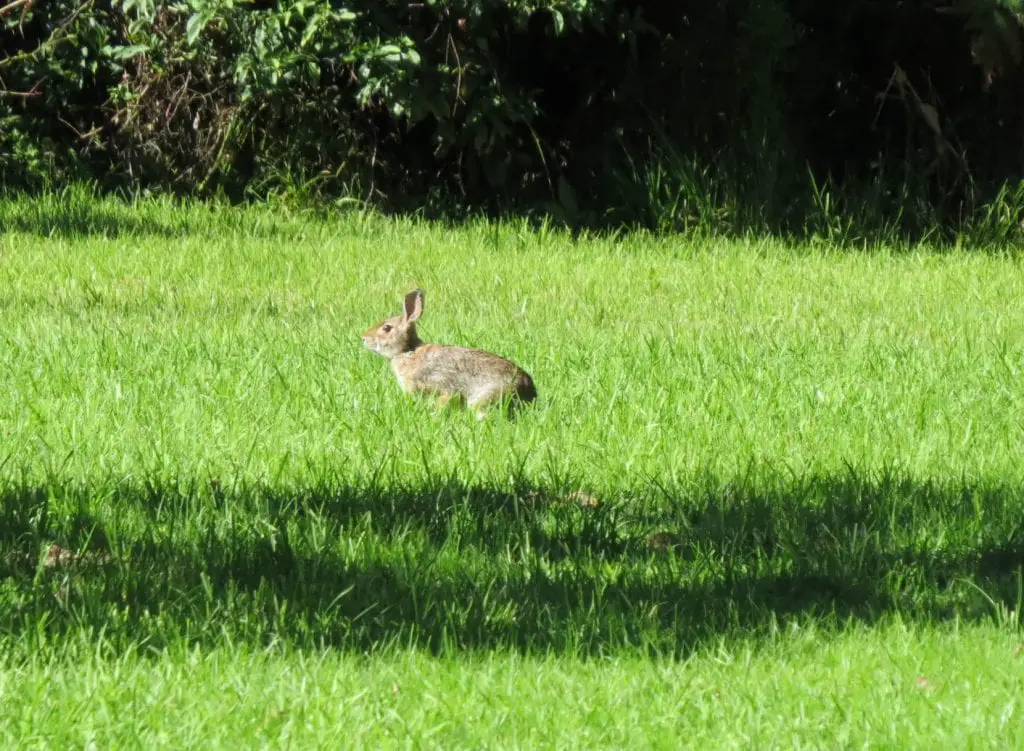Scientific Facts
| Common Name: | Mexican Cottontail |
| Scientific Name: | Sylvilagus cunicularius |
| Life Span: | 3 years in the wild, 8 years in captivity |
| Size: | Medium-Large |
| Habitat: | Subtropical or tropical dry forests, temperate forests, pastureland |
| Country of Origin: | Mexico |

Physical Description
Mexican Cottontails are included in the list of biggest members of its breed. They weigh around 1,800 to 2,300 grams and are considered to be the biggest Mexican rabbits. Their fur is either greyish-brown or reddish-brown. Their underparts are white. Upon reaching their maturity period, the fur turns duller, yellowish-gray shade. The dimensions of the external body include a body length that is 19.1 to 20.3 inches, a tail length that is 2.1 to 2.7 inches, hindfoot length that is 4.3 to 4.4 inches, and ear length that is around 2.4 to 2.5 inches.
These creatures are also known for their rough coat and enormous skull. The fur is distinctly spongier compared to eastern cottontail. They have backs that are lightly haired and gray with the uttermost edges and the exterior tips darkening turning to black, although not as extrusive as in the eastern cottontail.
Lifespan
The average lifespan of Mexican Cottontail in the wild is commonly less than 3 years. In captivity, these creatures are said to reach a lifespan of 8 years. The existence of these creatures would entirely depend on significant factors. Rabbits in captivity are said to live longer because they are likely to be exposed to a much safer and suitable environment. If given proper care along with a healthy diet, Mexican Cottontails can live even longer.
There are several reasons why some of these creatures cannot endure their environment. Men produced fire as well as volcanic activity, and these things injure the Mexican Cottontails. Reduction in habitat is approximately between 13 to 23 percent over the past 3 generations. People hunt these rabbits and use them for different purposes. Many of these creatures cannot survive long because they are murdered by predators too.
Eating Habits
These rabbits are characterized as nocturnal and crepuscular. Their feeding activity normally happens 2 to 3 hours past dawn and during the hour past sunset. Mexican Cottontails in the wild indeed enjoy their plants. They are somehow selective about how they are going to eat them. They are commonly more anxious about eating foliage over stems. They also like to feed on new plants if there is an opportunity. They do not prioritize dry plants. Cottontails in captivity follow a diet similar to those in the wild. They eat plenty of hay.
Their eating schedule is quite reliable. They feed first thing in the morning and again right at the onset of the evening. Remember, as an owner of Mexican Cottontail; you should not feed your rabbit with anything new unless you have obtained the approval of your veterinarian.

Sleeping Habits
Mexican Cottontails do sleep. They can even sleep while their eyes are open. You would normally notice this, especially if you have just moved them to a new home, where they generally sense the absence of security. It is only when the rabbit begins to feel confident in its new environment that you will be able to notice it sleeping soundly.
These creatures are characterized as crepuscular. They are seen very active during the early morning and late evening or early night. Hence, these are the best times to interact with your rabbit. Nevertheless, the survival of your pet depends on its regular condition of watchfulness.
The major sleeping habit of cottontail rabbits is that they can still get a nap with their eyes open. This is how they keep themselves alert to any kind of danger that may be hiding. Mexican Cottontail rabbits require time to be comfortable, especially if the environment is new to them. They also need a quiet environment for them to feel at ease.
Development and Reproduction
The doe builds a hollow nest which is composed of grass and stuffed with fur. Here, you will notice the young to stay hidden through leaves or litters. The female cottontail can breed the same day that the litter is born and can do again the process of young rearing 3 to 4 times during the season of breeding. Another nest is commonly built for every litter.
The milk of the doe is exceptionally abundant. The young are nurtured once or two times a day for 3 to 5 minutes at a time.
How to Breed
Determining the Sexes
Mexican Cottontails can be sexed by checking their physical bodies. To determine the sex of your rabbit, it is recommended that you do it once it reaches at least 4 weeks of age. Male Mexican Cottontails are determined through their testicles, which are seen in its groin right in the center of its back legs.
Genital openings can also be inspected to see whether the rabbit has a penis or vulva. The penis is for male cottontails while vulva is for female cottontails.
Courtship and Mating
Actively reproducing female Mexican Cottontails are existing throughout the year, however, with an eminent peak during the period of March to October. Juveniles occur throughout the year, however, with a pinnacle from September to December. Adult Mexican Cottontails have scrotal testes throughout the year without seasonal alteration in the length of the testis. Commencement of the breeding season coexists with heightening day length as well as temperature, and bearings with great rainfall. Hence, in central Mexico, Mexican Cottontails breed the entire year but specifically during the months with warmer and wetter summer climates.
Eggs and Incubation
Even though they are not considered as tunnel-living animals, a few days before the delivery, female Mexican Cottontails dredge a nursery tunnel in which they built a nest. These burrows are shallow and short tunnels with an average length of 23 centimeters, commonly found below shrubs or grass tussocks, and ceasing in a nest cubicle an average 17 centimeters below the surface. Nests are composed of oat straw, alfalfa hay, chunks of woody plants, dry grass, and pine needles given as an augmenting food; fur dragged from the body of the mother, as well as her fecal pellets. Mothers nurture their babies at the entrance of the burrow, and until the babies reach the age of approximately 12 days old, they seal the entrance after every visit in such a manner as to make it extremely hard for men to discern.
Common Health Problems
Most Mexican Cottontails exposed to medical treatment are young. The common reason for this exposure is trauma. Other common health problems among Mexican Cottontails include the following:
Ectoparasites
Ectoparasites such as mites, lice, ticks, and particularly fleas are often noticed on Mexican Cottontails.
Cuterebra Cutaneous Myiasis
This disease is also known as bots or warbles. Huge fly larvae are normally seen in the subcutaneous skin of the chest and neck during the months with warm weather. Adult flies affect the rabbit by laying eggs on its fur, which afterward hatch into larvae, which prick through the skin. Cuterebra larvae flourish until they reach around 1.5 inches long, by which they turn up from the skin of the rabbit and fall off. Then, the larva tunnels into the surface where it becomes a pupa and afterward come up as an adult fly. There is peculiar mortality in infected Mexican Cottontails.
Coccidiosis
Coccidiosis is seen in many cottontails. The E. perforans and Eimeria media can damage the intestines, possibly leading to lethal enteritis in afflicted juveniles. Hepatic coccidiosis is triggered by E. steidae.
Fibroma Virus
Fibroma virus is a segment of poxvirus, triggers rabbit horns or Shope’s fibroma. This disease is expanded through the arthropod vector. Skin lesions are sometimes noticed on the feet, legs, and ears of Mexican Cottontails. Lesions start as mild swelling of the subcutaneous tissues and improve after some months before immediately deteriorating. Papillomavirus triggers horny warts on the ears, shoulders, abdomen, or neck of Mexican Cottontails. Unfortunately, there is no medication yet for either kind of skin lesion, and the two conditions are commonly fixed spontaneously after some months.
Staphylococcus Aureus Infection
This kind of infection is expanded through insect bites or skin abrasion. Infection may demonstrate as lymph node abscessation, and may even turn systemic. The diagnosis of this disease is verified and confirmed through bacterial culture.
Preventing Illnesses
As a responsible pet owner, you have to be conscientious enough to apply preventive measures to inhibit your Mexican Cottontail from getting sick. A sick pet is already considered a casualty regardless if it overcomes the sickness because it has already consumed your time, its quality is reduced, and even the medications used to cure it can be expensive. To prevent illnesses among your pet, it would be best if you never lend your bucks to other breeders of rabbits. If you are suspecting a disease, it would be best if you thoroughly disinfect your entire equipment. Regularly clean the cages and secure moisture and droppings from gathering in the pans. It is also important that you regularly disinfect the bowls for water and food. Nest boxes should be thoroughly cleaned too after use.
Behavior
Mexican Cottontails are cottontail rabbit species belonging to the family of Leporidae. They normally take haven on pastureland, subtropical or tropical dry forests, and temperate forests. These creatures often act as the poster child for the prey species while they carry out an unbiased game for almost all predators. They happen to be jittery and get stressed easily. Owners should know that these rabbits do not carry well the austerities of captivity and must be kept in captivity as limited as possible.

Habitat
Enclosure
If you intend to keep your Mexican Cottontail indoor, then make sure that you provide it an adequate shelter or cage. The cage should have a dimension that is enough for the rabbit to conveniently move around. The caging materials must include components that are not easily gnawed or destroyed.
Toys
Your Mexican Cottontail rabbit needs to have fun while it is inside the cage. One important activity that your pet needs to maintain its health is mental stimulation. Toys can help your pet achieve this stimulation. However, when giving toys to your pet, make sure that they are rabbit-safe and that they do not contain toxic chemicals that can be harmful to the rabbit.
Diet
Mexican Cottontails eat on seeds, branches, leaves, bark, grass, twigs, fruits, flowers, and buds.
How to Care for Mexican Cottontail
To properly care for Mexican Cottontail, you should make sure that you are feeding it with a healthy and balanced diet. Its environment, particularly the cage, must be kept cleaned to prevent illnesses. Secure an appropriate visual shield such as a hide box and keep the Mexican Cottontail as distant as possible from the smell, sound, and sight of cats and dogs. And most importantly, being a responsible owner of your rabbit, show sincere love and concern to your pet.
Availability – Where to Get One?
Mexican Cottontails that are obtained from shows are commonly caught in very annoying environments. If you have other means of getting your new rabbit, you should not consider buying one from the shows. Bear in mind that the greater level of contact that they will have with other kinds of animals during the time that they are in their shows, their probability of getting ill and infected also gets higher.
Cottontails which are bought from a credible breeder are less possibly to experience ailments and illnesses. Still, you must take the applicable precautions to guarantee that they are not going through a contagious disease. Also, bear in mind that young cottontails are more vulnerable to diseases than the adult ones. These creatures can endure too much cold and low temperatures; however, drafty and wet conditions may weaken their defiance against disease organisms.
FAQs
Is it okay to wake up my Mexican Cottontail rabbit from its sleep?
Definitely, not. You should know that your Mexican Cottontail rabbit follows a sleeping pattern. Disturbing it from its sleep may only lead to an unpleasant mood. Your rabbit might even attack you for committing that big mistake.
Can Mexican Cottontail rabbits be carnivores sometimes?
No. These creatures are characterized as herbivores. They do not feed on meat. Their main diet includes plants and seeds.

